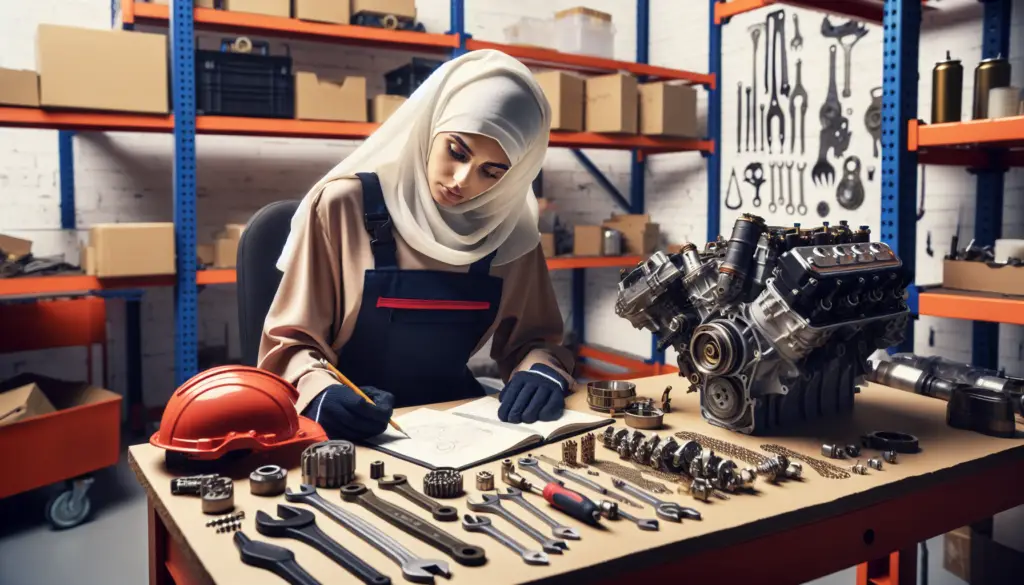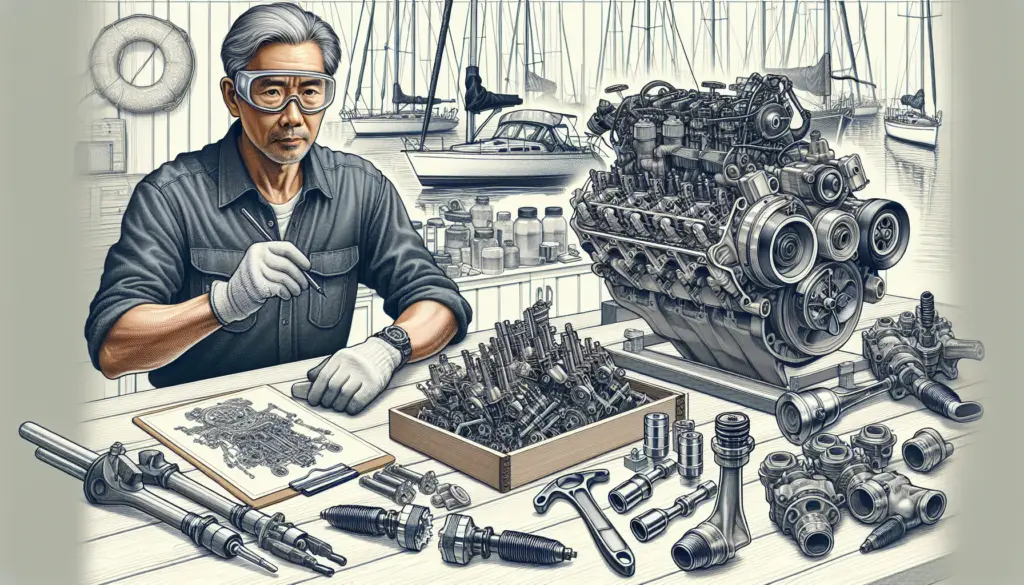Are you getting ready for a boat engine overhaul? Understandably, that can feel like a daunting task. “Expert Tips For Boat Engine Overhaul” is packed full of handy recommendations and advice that’s been shared by industry professionals. This practical guide will ease your apprehensions and equip you with the knowledge you need to approach the overhaul process with confidence. Trust us; you’ll be back on the water in no time if you diligently follow every piece of advice we’ve archived for you.

Understanding the Basics of Boat Engine Overhaul
Boat Engine overhaul isn’t a term you hear every day, but if you’re a boat owner looking to keep your boat running smoothly, it’s one you absolutely should understand. A boat engine overhaul is the process of taking apart an engine, cleaning, fixing, or replacing parts as necessary, and then reassembling it. In simpler terms, it’s like giving your boat engine a deep clean and a once-over checkup to make sure everything is in tip-top shape.
What is a boat engine overhaul?
Performing a boat engine overhaul means to disassemble the engine, carry out thorough cleaning, inspect for any worn-out parts, repair or replace them, and finally reassemble the engine. It’s similar to rebooting your device to its factory settings – only, in this case, the vessel receiving attention is your boat’s engine.
Why is it necessary?
Boat engine overhauls are necessary because they prolong the life of the engine, improve performance, and help prevent future problems. Over time, wear and tear can accumulate and cause issues that can affect the boat’s overall performance. These can be prevented with regular overhauls, ensuring your boat stays in top condition for longer.
When should it be done?
There’s no set schedule for when a boat engine overhaul should be done. Generally, you should consider an overhaul if the engine has a significant number of hours on it, it’s showing signs of reduced performance, or if it’s been a long time since the last overhaul. Of course, if you notice any major issues like excessive smoke or unusual noises, an overhaul might be necessary immediately.
Identifying Signs of Engine Trouble
Identifying signs of trouble early can save you a lot of stress (and money) down the line. Here are a few things to keep an eye on.
Unusually high fuel consumption
An increase in fuel consumption can denote engine trouble. If you notice you’re using far more fuel than usual during your trips, it might be a symptom of an inefficient, struggling engine.
Decreased performance
Your boat not reaching its usual speed or struggling to maintain steady cruising speed can be another sign of engine trouble. A noticeable reduction in your boat’s performance often signifies an aging or faulty engine that could do with an overhaul.
Excessive smoke
Large quantities of black or white smoke emitting from your boat engine point towards a need for urgent attention. Excessive smoke signifies an issue with the engine’s combustion process and should be addressed immediately.
Unusual noises or vibrations
Lastly, listen out for unusual noises or vibrations. Unfamiliar, persistent sounds or stead vibrations could be a sign of an internal problem in the engine which necessitates an engine overhaul.
Preparing for the Overhaul
Before jumping into an overhaul, you need to prepare adequately to ensure a smooth process.
Gathering necessary tools and equipment
First, gather all necessary tools and equipment. The exact tools you’ll need will depend on your specific engine, but generally, you will need a range of wrenches, screwdrivers, plyers, and possibly specialized engine tools.
Creating a clean working environment
Next, organize a clean working environment. This is a crucial step in ensuring the efficiency and success of the overhaul process. A clutter-free, well-lit area makes it easier to keep track of parts and tools.
Choosing the right time and weather conditions
Finally, consider the time and weather conditions. This might seem trivial, but factors like lighting, temperature, and chance of rain can significantly impact your overhaul efforts.
Sourcing Quality Parts
Quality is key when it comes to engine parts. Using high-quality, authentic components in an overhaul ensures longevity, efficiency, and top-level performance.
Importance of using quality parts
Using quality parts in your overhaul is non-negotiable if you want a long-lasting, reliable engine. Quality parts contribute to superior performance, fuel efficiency, and overall increased lifespan of your engine.
How to identify authentic parts
Identify authentic parts by learning about your engine model and its needed components. Authentic parts often have identifiable marks, come in branded packaging, and usually feature accompanying documentation. Be aware of suspiciously cheap parts as they often denote poor quality.
Where to source them
You can source quality parts from authorized dealer shops, online retailers, or directly from the manufacturer. Be sure to buy from reputable sources to guarantee authenticity.

Deciding Between DIY Or Professional Help
While doing an engine overhaul by yourself can be cost-effective, hiring a professional saves you time and guarantees expertise.
Weighing cost against expertise
Cost-effectiveness is one of the main reasons some boat owners undertake DIY overhauls. But you must weigh the savings against the risk of potential mistakes due to lack of experience. Professional overhauls might seem expensive initially, but they pay off in the long run, ensuring things are done right the first time.
Understanding your skill level
Are you handy with a wrench and do you enjoy tinkering with machinery? If not, an engine overhaul might not be a DIY project for you. You need adequate knowledge, skill, and patience to accomplish this task.
Assessing the value of professional assistance
Professional mechanics possess the training, experience, and tools to handle the complexities of an engine overhaul. They can pinpoint and fix issues efficiently, turn the job around faster, and often offer warranties on their work. Considering this, you might find the value of professional help outweighs the cost.
The Process of Overhaul
A boat engine overhaul process involves several steps. Let’s delve into them.
Disassembling the engine
The overhaul process begins with carefully disassembling the engine. This means removing all parts, from the largest ones down to the tiniest screws. It’s important to keep track of all parts, preferably taking photos or labeling them, to ensure proper reassembly.
Cleaning and inspecting parts
Next, thoroughly clean all the parts. This is crucial to remove build-up, grime, or debris that might be causing performance issues. You should also inspect all parts for wear and tear, looking out for cracks, breaks, or any damage.
Replacing worn out components
After cleaning and inspecting, identify the worn-out components that need replacement. By replacing old, worn-out parts, you refresh your engine and enhance its life span and performance.
Reassembling the engine
Finally, with all parts cleaned, inspected and necessary replacements done, carefully reassemble your engine. Follow the manufacturer’s assembly guide to get right every step of the reassembly process and avoid errors.
Troubleshooting Common Overhaul Issues
Even after an overhaul, you may face some common issues that you should know how to troubleshoot.
Failure to start after reassembly
If your engine fails to start after reassembly, there could be multiple causes. Double-check your assembly work, ensure the spark plugs are firing correctly, the fuel supply is unobstructed, and that there’s no leakage.
Excessive engine wear
Excessive engine wear post-overhaul could indicate a lack of lubrication. Check the oil levels and replace the oil if needed.
Poor performance after overhaul
If your engine isn’t performing as expected even after an overhaul, a part could be installed incorrectly or there could be an unresolved underlying issue. It’s advisable to consult a professional in such a scenario.
Addressing leaks and noises
Leaks and noises should be addressed immediately to prevent further damage. Leaks can be plugged and unusual noises should be keenly inspected to find the root cause.
Maintaining Your Boat Engine Post-Overhaul
The maintenance of the engine after an overhaul can ensure it lasts longer and stays efficient.
Developing a regular maintenance schedule
Developing a regular maintenance schedule and sticking to it helps to keep track of your boat engine’s health. The schedule ensures each component of the engine is routinely checked, cleaned, and maintained.
Proper engine cleaning practices
Adopting proper engine cleaning practices helps prolong the lifespan of your engine. Regularly cleaning your engine keeps grime, dust, and other debris away from crucial components.
The role of regular servicing
Regular servicing from professional mechanics can help drastically in maintaining the performance of your boat engine. It allows for early detection of potential problems and timely correction to avoid bigger, costlier issues in the future.
Ensuring Safety During Overhaul
Overhauling a boat engine involves handling various mechanical parts, using tools, and sometimes dealing with chemicals and fuel. Therefore, safety is of utmost importance.
Working safely with engine parts
Working with engine parts requires care, patience, and precision. Always ensure your working space is adequately lighted and clear of distractions. Also, handle each part with caution as they can be sharp, heavy, or contain trapped pressure.
Using protective gear
Always use the recommended protective gear like gloves, safety glasses, and sturdy shoes while performing an overhaul. This will protect you from accidental injuries, chemical spills or sudden component failures.
Handling chemicals and fuel
Lastly, you may need to handle chemicals like solvent cleaners, or fuel during an overhaul. Always ensure you handle these substances in a well-ventilated area, far from open flames or significant heat sources. Also, consider using chemical-resistant gloves and eye protection.
Long Term Tips for a Healthy Engine
Let’s wrap up our in-depth look at boat engine overhauling with some long-term care tips for keeping your engine running smoothly.
Regular oil changes
Regular oil changes keep your engine well-lubricated and in good shape. Oil serves as a barrier between engine parts, reducing friction and wear. Change your oil regularly according to the manufacturer’s advice for a long-lasting engine.
Constant engine monitoring
Keep an eye on your engine’s performance and regularly monitor it for unusual noises, vibrations, decreased performance or increased fuel consumption. Immediate attention to these signs can prevent major future problems.
Timely repairs and replacements
One of the secrets of a healthy engine lies in timely repairs and replacements. Delaying necessary repairs can lead to more serious problems, so replace faulty components as soon as they’re detected to ensure your engine stays in the best possible condition.
So there you have it – the comprehensive guide to boat engine overhaul. Whether you decide to undertake the process yourself or hire a professional, understanding the ins and outs of an engine overhaul can help ensure your boat remains in prime shape year after year. Sure, it might seem like a lot of work, but when you’re out on the water, you’ll know it’s worth it. Remember, a well-maintained engine means a happy boat – and a happy boat owner.

